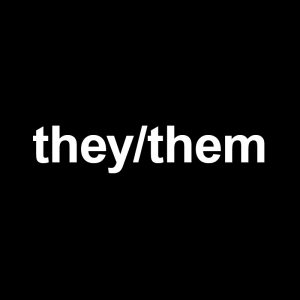Gender & Sexuality dictionary
gender-neutral pronouns
or genderless pronouns
What does gender-neutral pronouns mean?
Gender-neutral pronouns are pronouns which don’t carry any kind of association with a particular gender, such as they, sie, or ze. In English, the term gender-neutral pronouns usually refers to third-person pronouns (generally alternatives to he and she), since there are no gendered first- or second-person pronouns (I and you are ungendered).
Where does gender-neutral pronouns come from?

The concept of gender-neutral pronouns has existed since the late 18th century under various names. In 1808 Samuel Taylor Coleridge referred to the need for a “neutral pronoun” to use when referring to the word person rather than to a man or woman. In 1839, the Mercury And Weekly Journal of Commerce offered a prize of five dollars to anyone who could come up with “a really personal pronoun in the third person singular, without gender.”
These pronouns have also sometimes been referred to as common gender and epicene. These are more specialized grammatical terms, though. Gender-neutral is somewhat more intuitive, and seems to have emerged as the common way to refer to ungendered pronouns.
Examples of gender-neutral pronouns
Who uses gender-neutral pronouns?
This word is most often used in connection to two situations. The first is gender nonbinary people who prefer not to be referred to with gendered terminology. In this case, the pronouns he and she can be seen as too narrow to cover the identity of someone who falls outside the gender binary.
The second use case is for grammatical situations where gender is ambiguous, or is simply irrelevant, such as “Everyone should remember to bring their textbook to school tomorrow.” In this case, picking just he or just she may be inaccurate, and saying he or she is needlessly cumbersome when a simple they can be used. This is an indefinite use of gender-neutral pronouns—the gender of each person isn’t specified.
In both cases, singular they is a common option, though historically some style books and grammarians have considered it incorrect. However, acceptance of this use has been evolving. The American Dialect Society selected the pronoun singular they, especially in light of rising gender-neutral uses, for their 2015 Word of the Year on the heels of the news that the Washington Post would now allow this use in their articles.
The neopronoun is a specific type of gender-neutral pronoun. This refers to a newly-coined pronoun (think neologism) which has been created to fill the perceived lack of a gender-neutral option in English. Not all gender-neutral pronouns are neopronouns. Singular they has been used by the likes of Geoffrey Chaucer and Jane Austen. But pronouns like ‘e, eir, em’, coined by Michael Spivak in 1983, are recent additions to the language. Not all neopronouns are 20th-century inventions. The earliest attempt, ne/nis/nim, dates back to 1850. However, since the previous pronoun to enter English was its in the 16th century, even ne is comparatively new.
Gender-neutral pronouns, and neopronouns specifically, are not an exclusively English phenomenon. Swedish hen, a new gender-neutral coinage, was added to the official dictionary of the Swedish language in 2015.
Note
This is not meant to be a formal definition of gender-neutral pronouns like most terms we define on Dictionary.com, but is rather an informal word summary that hopefully touches upon the key aspects of the meaning and usage of gender-neutral pronouns that will help our users expand their word mastery.